ADC Study Reveals Future Trends in Ag Data Sharing, Storage
About two months ago, the Agricultural Data Coalition (ADC) put out a poll to see what farmers think the future might hold for farm data. With the turn of the decade, most were looking back at the accomplishments and changes over the last 10 years and what lay on the road ahead. No one could have guessed what was coming with the global pandemic – many aspects of our daily lives that have changed more in the last 60 days than they did in the last 10 years.
It is difficult to imagine what the new normal will be, however one thing is for certain: farming will continue. Seeds will be planted, livestock will be fed, and data will be collected. As promised in the last article, we will review the feedback from the future of farm data use survey, but keep in mind the results were largely gathered prior to the upheaval caused by the coronavirus. Thank you to everyone who took the time to complete the survey – without your participation, we would not be able to share this information.
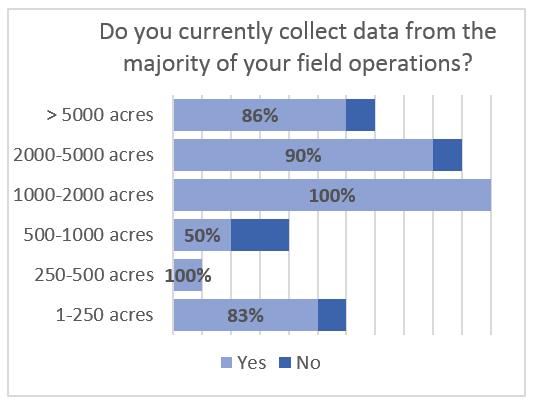 Before getting into the trends, let’s first review who responded: the majority of farms represented were in the 1,000 to 2,000- and 2,000 to 5,000-acre categories, followed closely by greater than 5,000-acre size, and then small farms under 250 acres. The fewest responses came from operations between 250 and 1,000 acres. This doesn’t quite follow the farm size distribution in the last census of agriculture conducted by the USDA, but does closely match the trends for farm sizes that have adopted the most precision ag technologies. We also had several agronomists or other service providers that responded to create the “other” category.
Before getting into the trends, let’s first review who responded: the majority of farms represented were in the 1,000 to 2,000- and 2,000 to 5,000-acre categories, followed closely by greater than 5,000-acre size, and then small farms under 250 acres. The fewest responses came from operations between 250 and 1,000 acres. This doesn’t quite follow the farm size distribution in the last census of agriculture conducted by the USDA, but does closely match the trends for farm sizes that have adopted the most precision ag technologies. We also had several agronomists or other service providers that responded to create the “other” category.
Next, let’s look at where farms are today with data use and sharing. Nearly all farms represented in the survey have equipment capable of collecting data with the majority also using the capability during field operations like planting, harvesting, or spraying. Farms between 250-500 acres, however, indicated they do not have equipment capable of collecting data, though some operations use smartphones and apps to collect data, so a lack of technology on machines may not prevent data use. So, a lack of precision technology on machines for these producers may not prevent data use entirely.
MORE BY AGRICULTURAL DATA COALITION
These results clearly reflect trends in equipment capabilities and integration of technology as standard equipment by most manufacturers. When it comes to data management, 73% of respondents have data stored with one to three service providers or systems, and are sharing data with the same number of providers or systems, for data-related services like variable-rate prescription map creation.
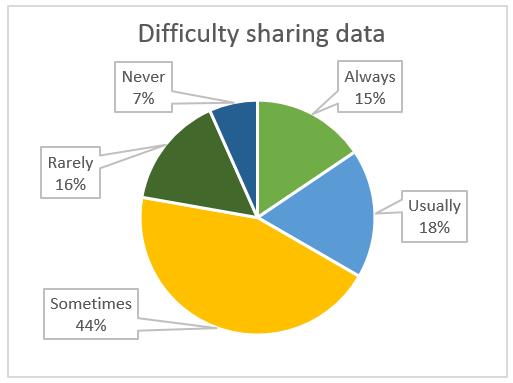
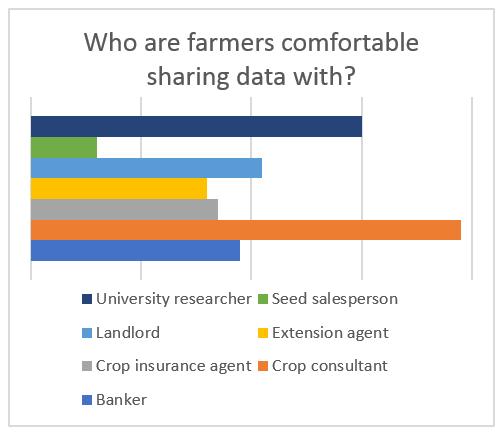
However, when looking at the difficulty in sharing data, over one-third indicated they usually or always have difficulty. Only a quarter of respondents rarely or never had problems getting data from one system or service provider to another. Almost every respondent (98%) indicated they saw a need to move data from one system to another.
Clearly, there is a need to share data with trusted advisors or companies providing services. Who are farmers comfortable sharing data with, given these difficulties? Number one on the list, not very surprisingly, is their crop consultant, followed by university researchers. Next the banker, crop insurance agent, extension agent, and landlord all had similar responses. The seed salesperson rounded out the list of trusted providers from the survey. Most respondents selected more than one of these individuals, highlighting the requirement for multiple people needing access to the same data for different purposes in these operations.
With the baseline established that most farms are collecting data, storing it with multiple systems or service providers and generally encountering difficulty sharing data, what does the survey show for the future? Ninety percent of survey respondents indicated they anticipate using more data in their farm operations in the next 3-5 years, with 71% saying they will be sharing more data over the same period. About half of the responses indicated they anticipate sharing data with more systems or service providers in the coming 3-5 years as well. These responses highlight the growing difficulty for farm operations looking to use data more within their operations in the years to come. If nothing changes, this could mean growing frustrations as farms try to share and use more data with more services providers or systems.
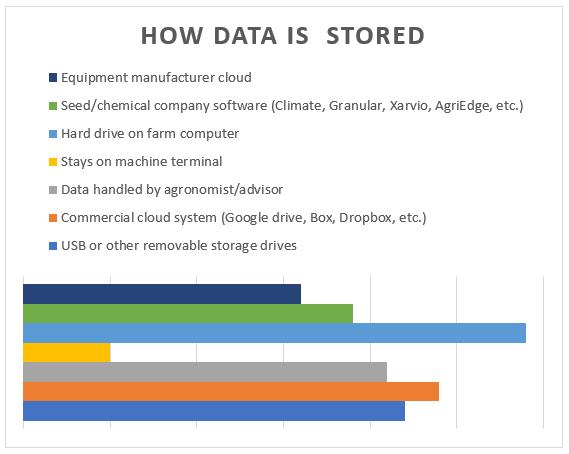 The survey clearly revealed an expected need to share data and share it with multiple systems and service providers going forward. That begs the question, of where are farmers storing this data today, and how do they grant access to their information? Farmers could select as many systems from the list as they wanted, based on the assumption that data is likely stored in more than one location already. Results indicate farm data is stored in variety of different tools, with the farm computer coming in slightly ahead of all other options. Using an online drive or other commercial system, USB or external drives, and/or just letting the agronomist handle it, were all very close as the second most common response.
The survey clearly revealed an expected need to share data and share it with multiple systems and service providers going forward. That begs the question, of where are farmers storing this data today, and how do they grant access to their information? Farmers could select as many systems from the list as they wanted, based on the assumption that data is likely stored in more than one location already. Results indicate farm data is stored in variety of different tools, with the farm computer coming in slightly ahead of all other options. Using an online drive or other commercial system, USB or external drives, and/or just letting the agronomist handle it, were all very close as the second most common response.
Many are also using the systems provided by seed, chemical, or equipment companies as well. Thankfully, only a very small segment is using the machine terminal itself as the primary storage location; in-cab terminals are not designed for long-term storage of large amounts of data. Using these machine terminals for this purpose creates a high risk of data being lost. Another positive note is only a handful of farms indicated they are sharing their credentials to various systems to allow service providers to access their data. This sharing would be similar to giving an input supplier bank account credentials so they can pay themselves as needed.
One aspect of farming likely not only requiring the use of more data but also generating new and information, is the use of autonomous farm equipment. Responses on this topic were split fairly evenly with 53% thinking they will not be using autonomous equipment in 3-5 years, and 47% thinking they probably will. With all the focus on this topic in the industry, it will be interesting to see if data management headaches are amplified by growing use of autonomous equipment.
What other impacts were foreseen as a result of all the data being generated in farming operations? Regarding the potential impact to farm land values of farm data, just over half of responses, 58%, think land values will be impacted by the amount of production data available for the land, while 42% believe it probably will not be a factor. The idea here is having historical yield, fertility, or other information about a piece of land could boost its value. Loans are a different story however, with 87% believing banks and other lenders will require yield, as-applied, or other production data to secure financing in the next 3-5 years.
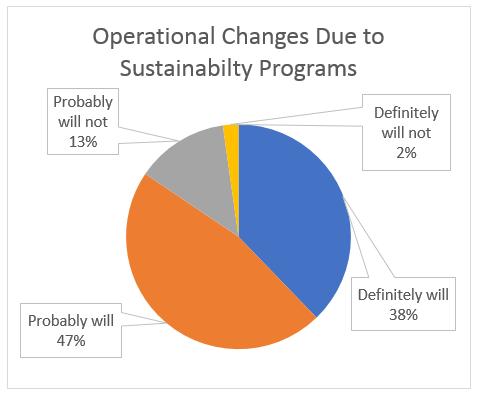 Another topic often tied to farm data is the implementation of sustainability or other environmentally-focused programs which generally require some sort of site-specific information to report on topics like nutrient use. When asked if they expect to make changes to their operation as a result of one of these programs in the next 3-5 years, 85% expect they probably or definitely will.
Another topic often tied to farm data is the implementation of sustainability or other environmentally-focused programs which generally require some sort of site-specific information to report on topics like nutrient use. When asked if they expect to make changes to their operation as a result of one of these programs in the next 3-5 years, 85% expect they probably or definitely will.
We also had a few questions directly related to the mission of the ADC. Eighty-four percent of respondents saw a need for an independent, secure, web-based data storage system for original data files that would also facilitate data sharing with whomever the user chooses. This is one of the core reasons the ADC was founded: the need to have data in one secure location the farmer controls independent of any influence from an input supplier, service provider, or equipment manufacturer.
Additionally, when asked if it is important for universities to have a means to access field-scale data to independently validate and assess new technologies and farming practices, 82% thought it was somewhat or extremely important. This is another primary focus for the ADC: we provide research institutions a means to manage data for research projects. The ADC environment allows participating farmers access to the precision data they choose so universities can use real, field-scale data to create fact-based insights regarding the issues facing modern agriculture. A similar percentage also indicated they would be willing to share their farm’s data with a university as part of a research project, underscoring the need for our public institutions to continue to be a source of independent, data-backed information regarding new technologies and farming practices.
In conclusion, the farmers that responded to our survey believe data use and the need to share more information with more people is going to increase. Many are already collecting and sharing data today, despite regularly encountering obstacles. Universities need to continue to play a key role in using data to create public, independent insights on a large scale, not just in trial plots. Farmers trust these institutions with their data for these purposes. Also, there is a need for an independent repository to help facilitate storage and sharing of data in a location the farmer controls. If you are interested in learning more about the Ag Data Coalition or supporting our effort, please email [email protected]. Hopefully, you find this information useful in determining the role farm data will play in your operations and what services and systems you will share data with.










